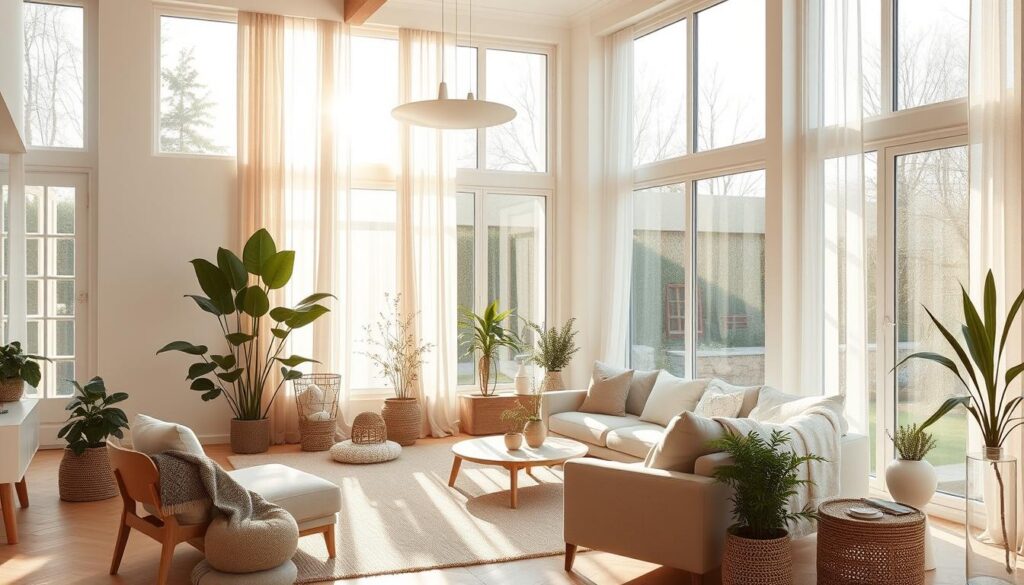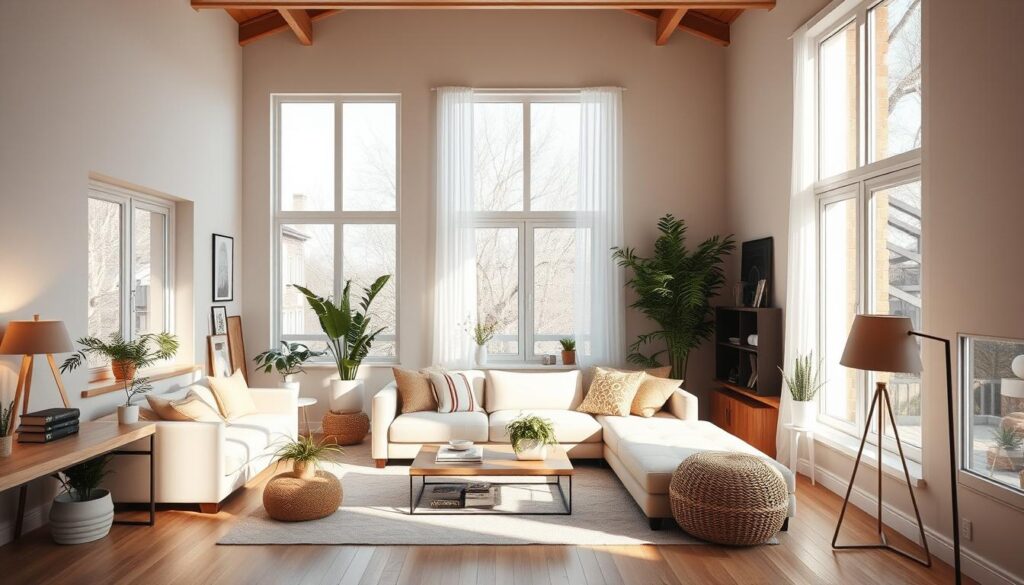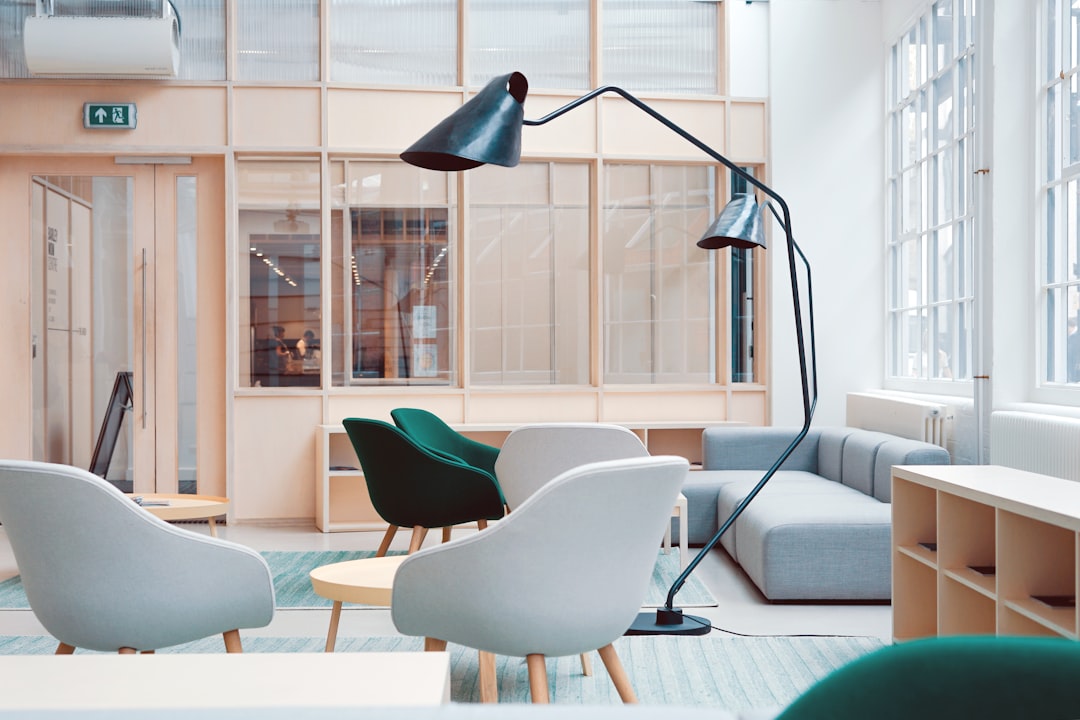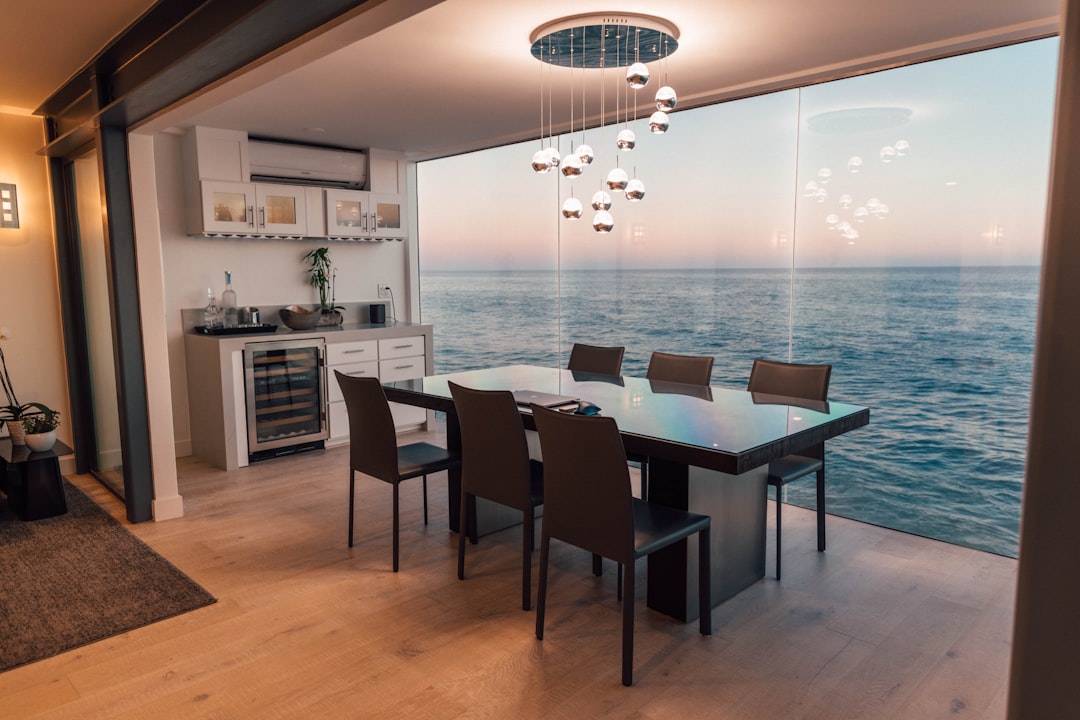Did you know that maximizing natural light can make your home feel bigger and better? Studies show homes with natural light are healthier and happier. They feel more welcoming.
We think it’s key to incorporate sunlight into interior design. It makes your space feel alive and welcoming. This article will show you how to use natural light in interior design to improve your home.
Key Takeaways
- Understand the importance of natural light in home design
- Learn how to maximize sunlight in your living space
- Discover practical tips for incorporating natural light into your interior
- Explore the benefits of a well-lit home on your well-being
- Find out how to create a brighter, more inviting home
The Importance of Natural Light in Interior Design
Natural light is key in interior design. It affects our mood, how productive we are, and how much energy we use. It makes a space feel more open and inviting.
Benefits of Natural Light
Natural light has many benefits. It boosts our physical health and makes spaces look better. It helps our bodies make vitamin D, keeps our body clocks in check, and can even help our eyes.
It also boosts our work performance and happiness. Research shows that people working in bright offices do better and are happier.
Key Benefits:
- Improved physical health
- Enhanced mental well-being
- Increased productivity
Psychological Effects
Natural light has a big impact on our minds. It makes us feel better, lowers stress, and can help with depression. Without it, we might feel lonely and uncomfortable.
“Light is a huge factor in our mental health and well-being. When we’re exposed to natural light, our mood and energy levels improve.”
Energy Efficiency
Natural light also helps save energy. By using more natural light, we need less artificial light. This cuts down on energy use.
| Benefits | Description | Impact |
|---|---|---|
| Physical Health | Boosts vitamin D levels, regulates circadian rhythms | Improved overall health |
| Mental Well-being | Uplifts mood, reduces stress | Enhanced mental health |
| Energy Efficiency | Reduces reliance on artificial lighting | Lower energy consumption |
Designing Rooms to Maximize Natural Light
Natural light is a valuable resource in interior design. It can make rooms brighter and more inviting. By planning the layout and elements, we can let in more natural light.
Open floor plans are a great way to maximize natural light. They reduce walls and partitions, allowing light to flow freely. Design experts say, “Open floor plans can significantly enhance the distribution of natural light throughout a home.”
Open Floor Plans
Open floor plans are great for small homes or apartments. They make spaces feel larger by removing barriers. This lets natural light reach deeper into the home.
For example, combining kitchen, dining, and living areas into one space helps distribute light evenly. This makes the area feel bigger and improves the ambiance.
Strategic Furniture Placement
Strategic furniture placement is also key to maximizing natural light. The way we arrange furniture can affect light flow in a room.
To let in more light, avoid big furniture in front of windows. Choose smaller, minimalist pieces that let light pass through. “Avoiding large furniture pieces in front of windows is key to maintaining the flow of natural light.”
Using mirrors can also boost natural light by reflecting it. This makes the room feel brighter and larger.
“The strategic use of mirrors can significantly enhance the natural light in a room, making it feel brighter and more spacious.”
By using these strategies, we can make homes more energy-efficient and welcoming. They become more comfortable and inviting.
Choosing the Right Window Treatments
Choosing the right window treatments is key to natural lighting in your home. The type of treatment you pick can greatly affect how much natural light gets in. We’ll look at the different types and how they impact lighting.
Types of Window Treatments
There are many window treatments out there, each with its own benefits. You can choose from curtains, blinds, shades, and shutters. Curtains and drapes come in various materials, from light to heavy. Blinds let you adjust the light with ease.
Light Filtering vs. Blackout Options
Choosing between light-filtering and blackout treatments is important. Light-filtering options let in natural light while keeping privacy. They’re great for living rooms and kitchens. Blackout options, on the other hand, are best for bedrooms and media rooms where you want it dark.
Experts say using sheer or light-filtering curtains and blinds is best. They let sunlight in while keeping privacy. This helps us achieve our goal of enhancing spaces with natural light.
| Feature | Light-Filtering | Blackout |
|---|---|---|
| Purpose | Allows natural light in while maintaining privacy | Blocks out light for darkness |
| Ideal Rooms | Living rooms, kitchens | Bedrooms, media rooms |
| Material | Sheer fabrics, translucent materials | Thick, opaque materials |
Color Schemes That Enhance Natural Light
Using color wisely can make your home feel brighter and more inviting. Color schemes are key in making the most of natural light. They can either boost or reduce the light in your space.
Light vs. Dark Colors
Deciding between light and dark colors is important for brightening your home. Light colors on walls, ceilings, and floors reflect light, making rooms look bigger and brighter. Whites, pastels, and soft neutrals work well because they reflect a lot of sunlight.
Dark colors, on the other hand, absorb light, making rooms feel smaller and darker. They can add warmth and depth, but use them sparingly if you want lots of light. For example, a dark color on one wall can create a focal point without making the room feel too dark.
Using Reflective Surfaces
Reflective surfaces also help bring out natural light. Mirrors, glossy finishes, and metallic surfaces reflect sunlight, spreading it around the room. This brightens the space and adds visual interest.
For instance, a mirror opposite a window can reflect light into the room, making it feel brighter. Glossy or metallic finishes on furniture and decor also help bounce light, making the space feel more open.
By choosing the right colors and adding reflective surfaces, you can greatly improve your home’s natural light. This not only makes your home feel better but also saves energy by needing less artificial light.
Incorporating Mirrors for Light Amplification
Using mirrors is a simple yet effective way to boost natural light in your home. Mirrors reflect light, making rooms look brighter and more open.
Types of Mirrors
There are many types of mirrors for enhancing natural light. Here are a few:
- Flat mirrors: Ideal for reflecting natural light directly.
- Convex mirrors: Provide a wider field of view and can be used to reflect light around corners.
- Antique or ornate mirrors: Add a decorative element while still reflecting light.
| Type of Mirror | Effect on Natural Light | Aesthetic Appeal |
|---|---|---|
| Flat Mirror | Direct reflection | Simple, modern look |
| Convex Mirror | Wide-angle reflection | Unique, decorative |
| Antique Mirror | Soft, diffused reflection | Ornate, vintage appeal |
Placement Tips
Here are some tips for placing mirrors to enhance natural light:
- Place a mirror opposite a window to directly reflect natural light into the room.
- Use multiple mirrors to create a “mirror maze” effect, bouncing light around the room.
- Position a mirror adjacent to a window to reflect light into areas that are not directly lit.
Mirrors can greatly improve the natural light in your home. They make spaces feel brighter and more inviting. Whether you pick a simple flat mirror or an ornate antique, the right placement can significantly enhance your space.
Using Glass Elements to Enhance Light
Adding glass elements to your home can greatly increase natural light. This makes your living spaces feel brighter and more welcoming. It also makes them seem larger.
Using glass in your design brings many benefits. It can improve your mood and lower energy costs. Let’s see how different glass elements can help.
Glass Walls and Doors
Glass walls and doors let natural light move easily between rooms. They brighten up your home and make it feel more open. When picking glass, think about what you need, like clear or frosted glass, for the right mix of light and privacy.
Skylights and Glass Roofs
Skylights and glass roofs bring light from above. They light up dark areas like hallways and rooms. They also add a special touch to your home’s look.
When you put in skylights or glass roofs, think about their position, size, and type. This helps get the most light while avoiding problems like too much heat.
By using glass elements like walls, doors, skylights, and roofs, you can make your home brighter. It becomes a more welcoming place to live.
Landscaping for Optimal Light Exposure
A well-designed landscape can make your home feel more welcoming and airy. By planning your outdoor space carefully, you can let more sunlight in. This reduces the need for artificial lights and makes your home more eco-friendly.
Tree Placement
Tree placement is key for natural light. Trees can block or filter sunlight, depending on their size and type. Plant trees on the north side of your home to shade it in summer but let sunlight in winter.
Trimming and pruning trees and bushes near windows is also important. It lets more sunlight in and keeps your plants healthy. For more tips, visit https://lightscapestech.com/landscape-natural-lighting/ for expert advice.
Outdoor Structures
Outdoor structures like pergolas and fences also affect natural light. They can block or redirect sunlight, depending on their design. For example, a pergola with a slatted roof filters sunlight, creating dappled shade.
- Think about the orientation of your outdoor structures to get more sunlight.
- Choose materials that reflect or filter light, like glass or metal.
- Design your outdoor spaces to match your home’s natural light needs.
By planning your landscaping and outdoor structures well, you can brighten your home. Some important design tips for natural light interiors include using light colors and keeping windows clear of obstructions.
Layering Lighting with Natural Light
To make interior design better, we need to think about how to mix light sources. By blending natural light with artificial light, we can make spaces more welcoming and useful.
Lighting isn’t just about making a room bright. It’s about setting a mood that makes the space feel right. Good layering means using a variety of lights to create a cozy and inviting atmosphere.
Types of Functional Lighting
Functional lighting has a specific job, like lighting for reading or cooking, and overall room light. There are different lights for these tasks, like ceiling lights, table lamps, and floor lamps.
- Overhead lights give general light and can be ceiling fixtures or recessed lights.
- Table and floor lamps provide task light and can be placed to make light pools.
- Under-cabinet lights in kitchens and bathrooms add function and beauty.
Accentuating Natural Light Sources
To make natural light work better, we need to highlight it. Mirrors can reflect natural light and spread it around a room. Also, light colors on walls and ceilings help reflect light.
Knowing how to layer lights and highlight natural light helps us create spaces that are bright, beautiful, and comfy. This is a key part of natural lighting solutions for interior design.
Seasonal Considerations for Natural Light
As seasons change, natural light’s effect on our homes also changes. This means we need to adjust our design to make the most of natural light all year.
By understanding and adapting to these changes, we can improve our home’s natural light interior design. This makes our homes more inviting and saves energy.
Adapting to Seasonal Changes
Seasons bring different light angles and intensities. In winter, the sun is lower, giving us softer light. Summer brings direct, intense sunlight.
- In winter, bigger windows and skylights capture more light.
- In summer, smart window treatments block intense sunlight, saving on cooling costs.
By changing our design with the seasons, we can better use natural light. This improves both our home’s look and function.

Daylight Saving Time Effects
Daylight saving time (DST) changes how we see natural light at home. Even though daylight doesn’t change, our clocks do. This affects how we use natural light during the day.
To get the most from DST, adjust your lighting and routines. Start your day earlier to catch morning light, or change your evening plans to use more daylight.
- Change your window treatments to control light in the new morning and evening hours.
- Update your daily routines to use more daylight, less artificial light.
By paying attention to these changes and making a few tweaks, we can enjoy natural light all year. This is true even with the time change.
Sustainable Materials and Natural Light
The mix of sustainable materials and natural light is key in modern design. It makes homes eco-friendly and bright. Knowing how these materials boost natural light is vital.
Choosing sustainable materials can change how much light a room gets. Reclaimed wood, bamboo, and low-VOC paints are good for the planet and our health. They can be used in floors, walls, furniture, and decor, affecting light in a room.
Eco-Friendly Options
Eco-friendly materials cut down on environmental harm while adding beauty and function. Some materials, like those with high albedo, reflect light, needing less artificial light.
- Recycled Glass: In countertops, flooring, and decor, it reflects light, making rooms brighter.
- Sustainably Sourced Wood: It adds warmth and invites a sense of brightness. Plus, it supports green forestry.
- Low-VOC Paints: They improve air quality and come in finishes that enhance light reflection.
Thermal Performances
The thermal performance of materials is key for spaces that use natural light well. Materials with high thermal mass absorb and release heat, keeping temperatures steady. This makes spaces more comfortable and cuts energy use.
| Material | Thermal Performance | Impact on Natural Light |
|---|---|---|
| Concrete | High thermal mass | Absorbs and releases heat, can be finished to reflect light |
| Brick | Moderate thermal mass | Can be used to create features that reflect or absorb natural light |
| Insulated Panels | High insulation value | Can be used in walls and ceilings to maintain a consistent indoor climate, potentially affecting natural light diffusion |
By picking sustainable materials and thinking about their thermal performance, we can make spaces that are green and bright. This design supports a healthy lifestyle and lessens our environmental footprint.
Innovations in Window Technology
New advancements in window tech are changing how we use natural light at home. Windows play a big role in making our homes better. This is because of the need for energy savings and smart homes.
Energy-efficient windows and smart glass are leading the way. These innovations meet our needs for saving energy and making homes smarter.
Energy-Efficient Windows
Energy-efficient windows keep your home warm in winter and cool in summer. They use less energy for heating and cooling. This makes your home more comfortable.
Key Features of Energy-Efficient Windows:
- Double or triple glazing for better insulation
- Low-E coatings to block heat
- Gas fills for better thermal performance
Smart Glass Solutions
Smart glass lets you change windows from clear to opaque with a button. This gives you total control over light and privacy.
| Feature | Traditional Glass | Smart Glass |
|---|---|---|
| Light Control | Limited by window treatments | Electrically controlled opacity |
| Privacy | Dependent on window treatments | Instant privacy with opacity switch |
| Energy Efficiency | Basic insulation | Advanced insulation properties |
Adding these innovations to your home design can greatly improve natural light and ambiance. Your living spaces will feel better.
Real-Life Examples of Natural Light in Design
Using natural light can make a home feel amazing. We’ll look at how homes around the world use light to make spaces beautiful and useful.
Iconic Homes and Their Designs
Many famous homes are known for their smart use of natural light. For example, biophilic interiors use big windows and skylights. This lets light fill every part of the home.
Clerestory windows are another great example. They let light in from above. This cuts down on the need for artificial lights and makes rooms feel bigger.

Case Studies of Successful Projects
Now, let’s look at some projects that did well with natural light.
| Project | Design Feature | Impact of Natural Light |
|---|---|---|
| Residential Project A | Skylights and Large Windows | Increased sense of space and reduced energy consumption |
| Residential Project B | Mirrored Walls and Clerestory Windows | Enhanced brightness and visual connection to outdoors |
| Residential Project C | Glass Flooring and Sliding Glass Walls | Created a seamless transition between indoors and outdoors, maximizing natural light |
These examples show how creating airy interiors with natural light can change a home. It makes spaces welcoming and eco-friendly. By learning from these, we can make homes that are good for us and the planet.
In summary, using natural light in design is key to making homes better. By looking at successful projects and using features like skylights and big windows, we can make spaces full of light. This improves our lives.
Tips for Finding Inspiration
Exploring interior design with natural light is key to a well-lit home. Finding inspiration is essential. We can find ideas from many sources to improve our designs.
Resources for Design Ideas
Start by checking out design magazines, websites, and social media. Sites like Houzz and Pinterest are full of ideas for using natural light. You can also visit model homes or design exhibitions to see these ideas in action.
Eco-Conscious Design Communities
Joining eco-friendly design groups can be very helpful. These groups share tips on green materials and energy-saving designs. They keep us updated on the latest in natural light design.



